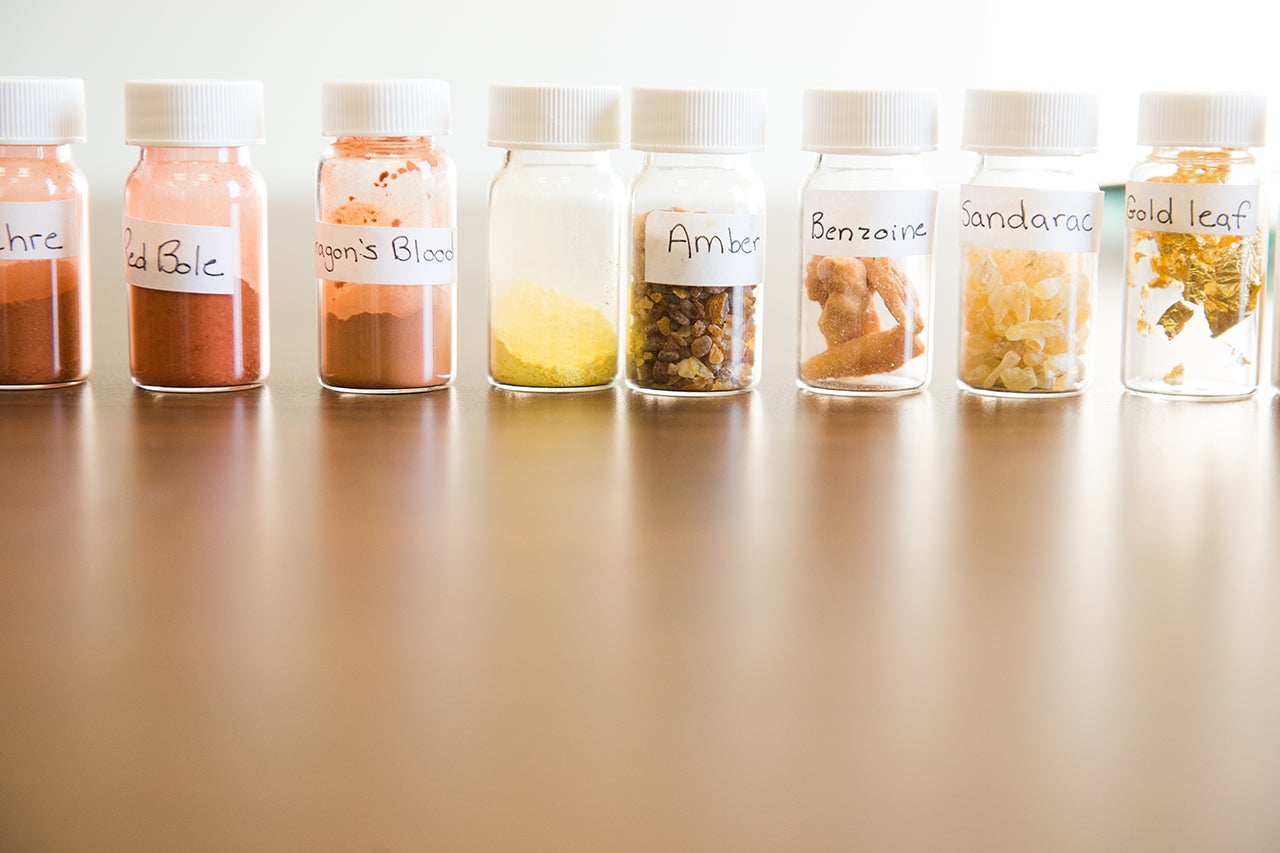In Professor Rebekah Compton’s class on the fourth floor of the Simmons Center, 14 students sit around a long rectangular table. The afternoon light streams in from several windows as the students carefully dab colors onto the wooden canvases they’ve each prepared with gesso. Around the table, paintings in various stages of completion are taking shape. Each one depicts a saint. If this were the 15th century, you might think you’d stumbled into an alterpiece workshop, but this an art history course examining the materials and techniques of Renaissance art.

Students in this art history course learn to prepare paint just as it was done during the Renaissance.
On another rectangular table nearby sit a range of colors in vials of powdered pigments that Compton has imported, most of them from Florence, Italy. The colors include cochineal red, malachite green, yellow ocher, turquoise verdigris and azurite blue and others. Students in this class have been learning not just where each color comes from and the processes used to derive them, but also how each was used by artists from that era.
For example, to paint depictions of the Virgin Mary’s robe, Compton says, Renaissance convention dictated that only deep ultramarine blue be used whenever possible. The powder in that particular vial was derived from lapis lazuli stone imported from Afghanistan and transformed into pigment via a laborious process just as it was done over 500 years before. Compton instructs her students on how to mix the powder with the proper proportions of water, egg and oil to render a fluid medium for painting.
“These students are learning that the processes involved in creating the materials that artists in the Renaissance used are quite involved,” she explains. “At the beginning of the course, I had the students start by making the rabbit glue binder for the wood. You have to cook that, so we had a hot plate in here. And then we had to brush the gesso on the panels and sand the surfaces before transferring the drawings onto them. There are quite a few steps involved.”
For the students, this course offers a chance to learn not just through lectures but experientially – by doing. “I really enjoy the hands-on aspects of this class,” says senior Neha Muppala, a double major in studio art and biology. “What’s inspiring is that this is an interdisciplinary course, so you get to see how science and art overlap. For instance, we’ve learned about the chemical properties of these pigments and how they interact when applied to various surfaces. That perspective helps you understand how DaVinci was both a scientist and an artist.”
For Katie Pocock, a sophomore majoring in art history, this class has been illuminating and fun. “I’m not an artist, I simply appreciate art, so it’s been fun to try painting and it definitely gives you an appreciation for just how difficult it must have been to create work like this. I now have a greater grasp of Renaissance art, particularly where different materials came from and how expensive and difficult they were to obtain.”

Professor Rebekah Compton, a specialist in the materials and techniques of Renaissance artists, assisting one of her students.
This is the first time that Compton has offered this course, but she’s sure it won’t be the last. “There’s been a lot of engagement among the students in this class,” she says. “We’ve been diving pretty deep into this subject matter, and there’s really a lot of material that we cover. I think the students have responded well to my formula of offering a lecture one day and then a painting session the next.”
Preparing and painting these saint panels is the final project for this class, but Compton explains that it has taken them all semester to get those pieces to this stage. “All in all, I think this has been a success. When you study colors this way, you go well beyond what they symbolize. You end up understanding a lot more about the meaning of an object when you learn about the materials that make up the paint and how that object is painted.”





